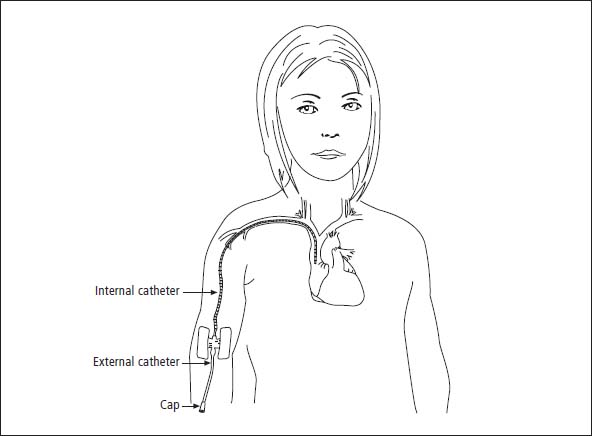Childhood Brain and Spinal Cord Tumors
Peripherally inserted central catheter
A peripherally inserted central catheter is also referred to as a PICC line. This type of catheter is placed in the antecubital vein (a large vein in the inner elbow area) and is threaded into a large vein above the right atrium of the heart (see Figure 9–4). Unlike other catheters, a PICC line can be inserted by an IV nurse, rather than by a surgeon.
The PICC line can remain in place for many weeks or months, avoiding the need for a new IV every few days. PICC lines can be used to deliver chemotherapy, antibiotics, blood products, other medications, and IV nutrition. When the PICC line needs to be accessed, an IV line is connected to the end of the catheter. When it is not in use, the IV is disconnected and the catheter is flushed and capped.

Figure 9–4: Peripherally inserted central catheter (PICC) line
How it’s put in
The PICC line can be inserted in your child’s hospital room by a nurse or doctor. Your child will be positioned on a flat surface, and he will need to keep his arm straight and motionless during the procedure. An injection to numb the area is given to decrease discomfort during insertion. A special needle is used to place the PICC line into the arm vein. The catheter is then threaded through the needle. Once the line is in place, a chest x-ray is taken to ensure that it is positioned properly. Some children may require light sedation during the procedure.
Care of the peripherally inserted central catheter
The PICC line, like the external catheter, requires care to prevent problems. The nurses will teach you how to change the dressing, flush the line, change the injection cap, and inspect the site for possible signs of infection. The dressing covering the exit site is changed once a week, or if it becomes wet or is exposed to air. The line must be flushed after every use, or every day. You should get plenty of practice under the supervision of a nurse until both you and your child are comfortable with caring for the line. The care required for your child’s PICC line may be slightly different from what has been described in this section, because institutional preferences vary.
Risks
Kelsey had a PICC line in her right arm, and she would not straighten it out, but kept it a little bent. I definitely think she was protecting it, and also I think when she tried to straighten it, it pulled on the suture and on the dressing in an uncomfortable way that could have been painful, so she just wouldn’t try. I had to do a heparin flush every day and change the dressing twice a week. She could not tolerate Tegaderm®, so we used another kind of porous adhesive bandage, and doused it with Detachol®, which dissolved the adhesive within a few minutes, allowing us to get the bandage off quite easily. The Detachol® was a godsend for her, as removing the adhesive was like pulling teeth and a source of unnecessary pain. [For more information about Detachol®, see the section “Adhesives” later in this chapter.]
The problems associated with a PICC line are similar to those of any external catheter. Veins may become irritated, infection can occur, or the line can be accidentally torn or moved.
Irritated veins
Within the first few days of insertion, the vein where the catheter is located may become irritated. Signs of irritation include swelling or pain in the area. Often, the discomfort can be alleviated by placing a warm, moist cloth or a carefully monitored heating pad on the vein. Elevating the arm on a pillow is also sometimes helpful.
Infections
Meticulous care using sterile techniques is extremely important to reduce the risk of infection. The dressing over the exit site should be changed every week, or if it becomes wet or exposed to air. Injection caps must also be regularly changed using sterile techniques when the line is not in use, and the line must be flushed on a regular basis. Signs of infection include redness, swelling, pain, drainage, or warmth around the exit site. Fever, chills, tiredness, and dizziness may also indicate that the line has become infected. You should notify the doctor immediately if any of these signs are present or if your child has a fever above 101° F (38.5° C).
Torn catheter
Accidents sometimes happen, and a hole or tear in the line can occur. Careful handling of the catheter can help prevent these accidents. You should suspect a torn catheter if fluid leaks out of the line, especially during an injection. If a tear is found, you should find the hole, fold the line above the tear, tape it together, cover it with sterile gauze, and immediately notify your child’s doctor.
Displaced catheter
As with other external catheters, a PICC line must be securely taped to the exit site to prevent movement. Signs of a displaced catheter include chest pain, burning or swelling in the arm above the exit site or in the chest, fluid leaking around the catheter, or pain when fluid is injected into the line. If you suspect that the line has moved, you should tape the catheter in place and immediately notify your child’s doctor.
Table of Contents
All Guides- Introduction
- 1. Diagnosis
- 2. The Brain and Spinal Cord
- 3. Types of Tumors
- 4. Telling Your Child and Others
- 5. Choosing a Treatment
- 6. Coping with Procedures
- 7. Forming a Partnership with the Treatment Team
- 8. Hospitalization
- 9. Venous Catheters
- 10. Surgery
- 11. Chemotherapy
- 12. Common Side Effects of Chemotherapy
- 13. Radiation Therapy
- 14. Peripheral Blood Stem Cell Transplantation
- 15. Siblings
- 16. Family and Friends
- 17. Communication and Behavior
- 18. School
- 19. Sources of Support
- 20. Nutrition
- 21. Medical and Financial Record-keeping
- 22. End of Treatment and Beyond
- 23. Recurrence
- 24. Death and Bereavement
- 25. Looking Forward
- Appendix A. Blood Tests and What They Mean
- Appendix C. Books and Websites

